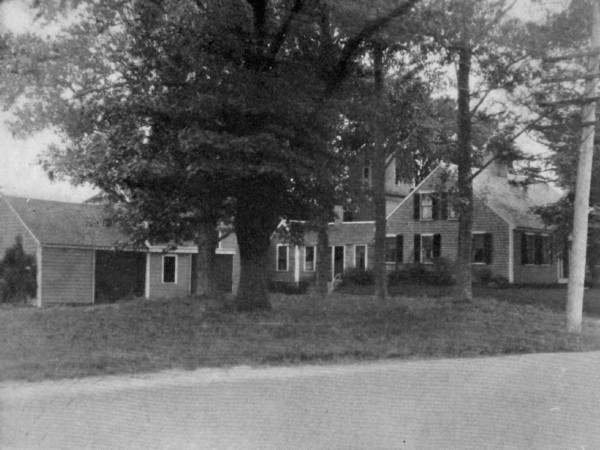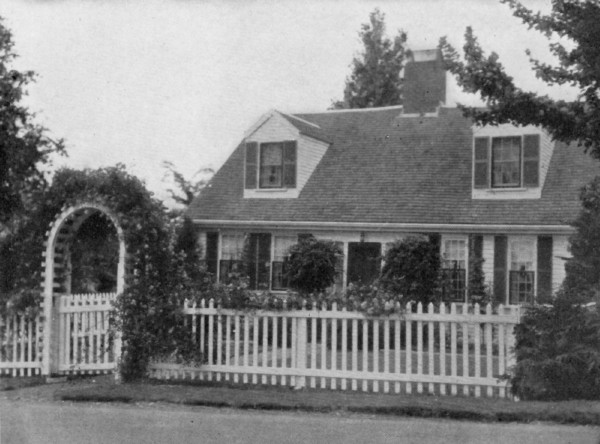| Web
and Book design,
Copyright, Kellscraft Studio 1999-2012 (Return to Web Text-ures) |
 (HOME)
|
| CHAPTER
X
A THRILLING ADVENTURE IN SECURING A FIREPLACE NEAR my town was an old house built in 1799. After 130 years this house was to be razed to make way for a new State Highway. It was a splendid example of honest workmanship. They were still using wide plank flooring, hand-forged nails and pegged oak frames when it was built. The ridge-pole was as straight and staunch as the day the house was finished. It was a landmark, good for another hundred years. The road contractor in charge of building this section of the highway was an Italian. He employed a Greek with a huge Mack truck, appropriately named 'The Brute," to fasten chains to the old house and yank it down. Thus does the decadent Anglo-Saxon race yield to two of the world's oldest civilizations, when they agree in a common cause. Thus also do we ruthlessly destroy some of the priceless heritages of our ancestors that would almost be shrines for our descendants. ''Sic transit gloria mundi" — when the transit happens to be in the hands of a young road surveyor who knows that a straight line is the shortest distance between two points.
By the merest
chance, I
was passing this old landmark when the son of the Italian road
contractor was directing the Greek how to attach the cradle of chains
most effectively. When the truck started to dig its toes in, the idea
was that the house must come down with a crash and thus save labor.
Fortunately some antique collector had already removed most of the
hand-forged hardware, but the house itself with its stone grist-mill
wheel for a doorstep, its cart wheel to dry the milk pans on, its
bell to call the farm hands to dinner, its butt end of an old cannon
for a hitching post, its staircase worn thin with the feet of five
generations, — all that was to be buried alive when the old Mack
began to heave. Nearby was a pile of new lumber, ready to start the
erection of a filling station by the roadside when the house was
gone. The lumber was now piled on a clump of century old boxwood,
crushing out its life.  Built in 1765 and showing the String of Outbuildings characteristic of Early New England Houses.  A few simple touches like a Picket Fence or a Rose Arbor make a lot of difference in the charm of an early American House.  Our Fireplace Frame, 131 years old, was rescued from a House about to be torn down. It is entirely hand-made, Mouldings and all. The Paneled Side Wall was especially made to match it.
When I arrived the chains were already adjusted and they were making a tentative pull to see if everything was O.K. for the final crash. As the chain grew taut, the old frame creaked and groaned at the unaccustomed indignity. Like Kipling's ship that found itself, this frame had already proved its ability to weather storms — a thousand of them — but here was a new kind of torture. That had never happened before in 130 years. I hastily glanced in the front door for a last look. To my amazement, they had left in place a fireplace frame, a graceful example of early craftsmanship entirely hand-made, of white pine. In another five minutes it was destined to be buried in the wreckage under the chimney. The fireplace frame was painted black. In spots the black had chipped off showing an undercoat of robin's egg blue. A pine plank, still bearing suggestions of adze and plane, formed the main panel. Under this panel were still evident the nail holes where for 130 Christmases the stockings had been hung. The chimney flue was almost big enough to let Santa Claus down, pack and all. The Hollywood, 18-day, reducing diet will never be popular with the old Saint. That is another reason for building your house with a big chimney. Seeing the ruin about to take place it took me but an instant to make up my mind. We Millers have always been quick thinkers in a crisis. For example, I invariably let someone else take the first dip in the ocean to tell me how cold it is. I don't eat canned lobster until someone else has survived it. I never argue with a traffic cop. In a trice I rushed up to the young Italian directing the operations of the juggernaut and offered him a dollar for the fireplace frame if he would give me but five minutes to remove it. Did you ever ask the man in the theatre box office if he did not have something better for your $6.60 each than a pair of seats in row Q behind a post? Well, the look he will give you is the same kind of a look this son of a bitumen road builder (Latin for ''asphalt") gave me. What interest was it to him if I wanted to salvage a priceless antique around whose hearthstone five generations of Americans had foregathered? He walked away and was about to give the signal to the Mack when I fairly shouted — "Well, how much then?" "Five dollars," said the noble Roman. ''Sold," I said rising to my full height, a complete master of the situation. In a few minutes I rode away, the fireplace frame tied to the side of my car. I turned the corner, when, with a groan of terror, and a huge cloud of dust, the old house crashed down and gave up the ghost. Now that I had the fireplace frame, what next? What was I to do with it? I had already made a contract for a new fireplace, which was to be a reproduction of one I had seen in Salem. This old frame on my car had mouldings, some of them missing, entirely unlike anything made to-day. To make the fireplace fit in as a part of the paneled side of my living room would require skilful cabinet work. But the local mill and woodworking man proved to be even more enthusiastic at the job of restoration than I was. He would be — as he ultimately charged me $110. for the job. But it was worth it. Now that it is finally in place, no one can detect just where the span of 130 years is bridged, or what is old and what is new. But in the long winter evenings, when the spectres of the past appear in the smoke, I can truthfully say, "Well, at least here is one antique that wasn't made last week for the benefit of Cape Cod tourists." One outstanding characteristic of many old houses is the use of flat arches with keystones. They were used in forming connecting colonnades over doorways and to form rose arbors. This arch motif is also seen in the Palladian windows. England had been famous for its stone masonry. What could be more natural than to make arches that looked like London Bridge or some old country house at Buxley, Stilton on Trent, Hadwych, N. W. But colonists formed their arches of white pine. It is a note of simple ornamentation that seems to furnish just the right touch. In Colonial houses, so far as I know, they seldom went beyond the simple flat arch and keystone. The use of Spanish, French Flamboyant and Tuscan arches, with spindles and tooth picks and gingerbread over windows and ridgepoles, happily was left to the genius who invented the slate-sided Mansard roof. So, too, paneled sidewalls either painted or left in the natural pine color are exceedingly common in early houses. They were a perfect background for the delicate furniture. The furnishings of houses of 1750 were all in harmony almost like an orchestra playing a Beethoven symphony. Static and sour notes began to creep in when Napoleon decided that because he was a great general, he was also no slouch of a furniture maker either. Most people consider early architecture an expression of the simple standard of Puritan taste. And so it was until people began to get money. When that happened there was probably just as much of a desire to keep up with the Joneses as there is to-day. By 1725 the so-called classic revival struck England and in a lesser degree America. Michael Angelo had taught the world that there was much beauty in Greece and Rome that could be adapted to the Nordics and Anglo Saxons. Then came the beginning of the baroque or ''rococo" style of architecture which has survived even to-day in gingerbread and fussyness. This isn't a book on the development of architecture. If it were, someone else would be writing it. But even a vacationist riding through New England can detect the change when houses and furniture began to be fancy. When you see an old, fat, low-to-the-ground house, with a big chimney and a picket fence and a string of out buildings, it is probably a house that dates around 1750 or earlier. You usually see them in the country districts. In New England towns you begin to see the more pretentious houses with higher ceilings and ornamentation of various kinds. Some of them had most elaborate doorways and hand carved picket fences. The single central chimney then was changed to two or three chimneys on the ends of the house. Frequently in the past, old houses were given a new scheme of interior decoration. Big fireplaces were boarded up or sealed in, to make room for smaller ones which the advent of the kitchen stove made possible. Exposed woodwork was covered with lath and plaster. Thus a house possibly originally dating 1650 was given some 1750 touches making it exceedingly difficult to fix its date at any definite period. The art of remodeling and redecorating houses to keep up with style changes was relatively just as common then as now. It is surprising that the houses and furniture of the early colonists were in such good taste when we honestly consider the facts. Those who lay claim to early American ancestry invariably try to connect it in some way with noble blood. To establish this they select some crest. As a matter of fact, most of the colonists came from the middle classes, the yeomanry of England. If these people did have access to the finer houses at home, they entered through the back door as tradesmen and artisans rather than as honored guests. There were few traditions of good taste among them. Life was pretty much of a struggle between Cromwell and the King, and the followers of each. The situation would be duplicated to-day if a company of garage mechanics, milkmen, carpenters, tailors, subway guards, farmers and A. and P. clerks emigrated to a new country because they were dissatisfied with the conditions at home. But those men and women were undoubtedly superior to a similar body today, even if the latter are "all American." Can you picture the gang that storms the South Station subway in Boston at rush hour to go over to Cambridge to sleep, founding a Harvard College nineteen years after they landed in a new country peopled with nothing but Indians and wolves? Do you think that David Neal would say in 1920 what he said in his history of Boston in 1720 — "The conversation of this town is as polite as in most of the cities and towns of England. Most of their merchants have traveled in Europe. A gentleman from there would almost think himself at home in Boston." |